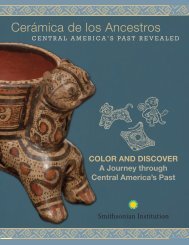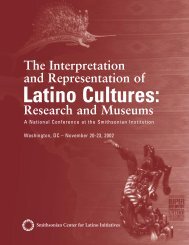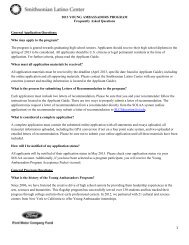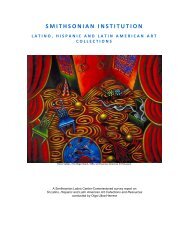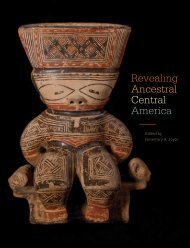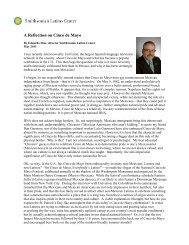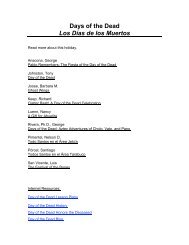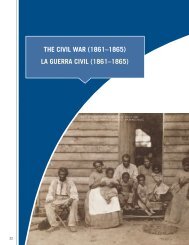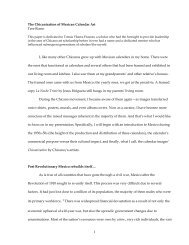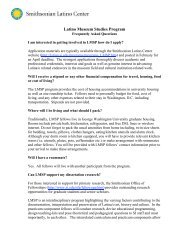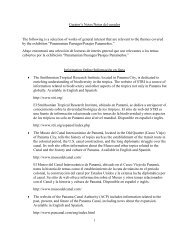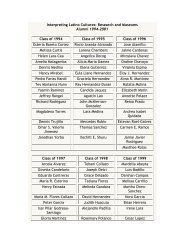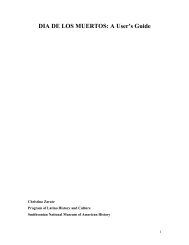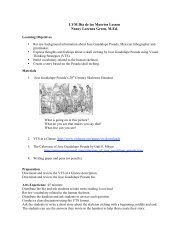postersdivisionofcomm unityeducation - Smithsonian Latino Center ...
postersdivisionofcomm unityeducation - Smithsonian Latino Center ...
postersdivisionofcomm unityeducation - Smithsonian Latino Center ...
Create successful ePaper yourself
Turn your PDF publications into a flip-book with our unique Google optimized e-Paper software.
P O S T E R S<br />
F R O M T H E<br />
D I V I S I O N O F<br />
C O M M U N I T Y<br />
E D U C A T I O N<br />
( D I V E D C O )<br />
O F P U E R T O R I C O<br />
1 9 4 9 - 1 9 8 9
A Poster is a Poster is a Poster<br />
I spent the year of 1990 in Puerto Rico doing research on the politics<br />
of culture. During my research, the Division of Community Education<br />
(DIVEDCO) came up over and over in conversations with artists,<br />
intellectuals and politicians. The books, posters, films, and other<br />
documents produced by DIVEDCO from 1949 to 1989 document<br />
and speak about the most important political period in Puerto Rico’s<br />
history. When I started working as a curator at the National Museum<br />
of American History in 1991, one of the first collections I was interested<br />
in bringing to the museum was the DIVEDCO collection of posters.<br />
I was struck not only by the interesting and sophisticated silkscreens,<br />
woodcuts and books produced by DIVEDCO, but also by the story<br />
of the connection between art and politics for didactic purposes. The<br />
idea that art can be utilitarian and put to use for political purposes is<br />
not a new one. Within the Russian and Italian neorealist movements,<br />
the production of propaganda films and posters were a trademark<br />
that later influenced the development of political artistic productions in<br />
Mexico, Cuba, and other countries.<br />
Anonymous, Democratic circle of community discussion, unknown date<br />
Courtesy of the DIVEDCO Collection, Photography Division,<br />
General Archive of Puerto Rico, Institute of Puerto Rican Culture<br />
Anónimo, Círculo democrático de discusión, sin fecha<br />
Cortesía de la Colección DIVEDCO, División de fotografía,<br />
Archivo General de Puerto Rico, Instituto de Cultura Puertorriqueña<br />
Anonymous, DIVEDCO crew and local actors filming Brainless John, c. 1959<br />
Courtesy of the DIVEDCO Collection, Photography Division,<br />
General Archive of Puerto Rico, Institute of Puerto Rican Culture.<br />
Anónimo, Equipo de DIVEDCO y actores locales filmando Juan sin seso, c. 1959<br />
Cortesía de la Colección DIVEDCO, División de fotografía,<br />
Archivo General de Puerto Rico, Instituto de Cultura Puertorriqueña.<br />
Puerto Rican artists and politicians were not exempt from these<br />
influences. In interviews with some of the artists and filmmakers of<br />
DIVEDCO, they mention how interested they were in Russian and<br />
Italian cinema, as well as Mexican mural traditions and how much<br />
time they spent trying to understand and absorb these aesthetics.<br />
After the Cuban Revolution of 1959 there was a development of Cuban<br />
graphic arts, especially poster art to praise and propagandize the new<br />
revolutionary government. Ironically, the posters in Cuba were used<br />
for the same purposes as the posters in Puerto Rico, but within very<br />
different political systems. Propaganda is propaganda is propaganda.<br />
This ephemeral art form made possible the dissemination of political<br />
messages within the medium of graphic art, particularly silkscreen,<br />
therefore creating a new form of political/artistic advertising.<br />
This exhibition shows, not only the didactic, utilitarian aspect of political<br />
and educational posters, but the development over the years of stylistic<br />
and aesthetic peculiarities in the graphic arts of Puerto Rico. From<br />
silkscreens to woodcuts, to linotype, lithography and other media,<br />
Puerto Ricans have become one of the most important producers of<br />
graphic arts in the world.<br />
Marvette Pérez
Puerto Rican Graphic Arts<br />
Puerto Rico has had a long tradition of poster art, however, it was not<br />
until the mid 1940s that silkscreen posters became an important form<br />
of artistic advertising for public health, education, and development<br />
programs. The formation of the Cinema and Graphics Workshop of<br />
Public Parks and Recreation (CGWPPR) in 1946, under the auspices of<br />
then President of the Senate Luis Muñoz Marín, established a connection<br />
between art, politics and the preoccupations with didactic endeavors.<br />
As an arm of the government, the CGWPPR, which became DIVEDCO<br />
in 1949, had a political and didactic agenda that constrained a purely<br />
aesthetic production, and at the same time created a space in which<br />
artists developed their craft.<br />
The creative incorporation of text and image, and the innovative use<br />
of typography and calligraphy, spearheaded by Lorenzo Homar, led<br />
to a refinement of the social, informational, and educational poster.<br />
Early on, many of the artists associated with DIVEDCO created the<br />
<strong>Center</strong> of Puerto Rican Art (CAP), an artist collective that promoted<br />
social justice. The CAP was the first of many autonomous workshops<br />
that would sprout in the following decades of the 1960s and 1970s;<br />
notable among these later workshops were Taller Alacrán, Taller<br />
Quinqué, Taller El Seco, and Taller Bija.<br />
José Melendez Contreras, Brainless John, 1972<br />
Puerto Rico Division of Education Poster Collection, Archives <strong>Center</strong>, National Museum of<br />
American History, <strong>Smithsonian</strong> Institution<br />
José Melendez Contreras, Juan sin seso, 1972<br />
Colección de carteles de la División de Educación de Puerto Rico, Centro de Archivos<br />
Museo Nacional de Historia Americana, Institución <strong>Smithsonian</strong>.<br />
José Meléndez Contreras,<br />
Your Health, 1967<br />
Puerto Rico Division of<br />
Education Poster Collection,<br />
Archives <strong>Center</strong>, National<br />
Museum of American History,<br />
<strong>Smithsonian</strong> Institution<br />
José Meléndez Contreras,<br />
Su salud, 1967<br />
Colección de carteles de<br />
la División de Educación<br />
de Puerto Rico, Centro de<br />
Archivos Museo Nacional de<br />
Historia Americana, Institución<br />
<strong>Smithsonian</strong>.<br />
The success of the graphic arts workshop of DIVEDCO influenced<br />
other government agencies. In 1957 Lorenzo Homar was recruited to<br />
open the Graphics Workshop for the Institute of Puerto Rican Culture.<br />
The University of Puerto Rico inaugurated print workshops headed by<br />
José Antonio Torres Martinó and Carlos Marichal. DIVEDCO played<br />
a significant role in the early years of the Puerto Rican graphic arts by<br />
creating a niche for experimentation and training whose alumni would<br />
go on to launched numerous workshops.<br />
María del Mar González-González<br />
Marvette Pérez is the curator of <strong>Latino</strong> History and Culture at the National<br />
Museum of American History of the <strong>Smithsonian</strong> Institution.<br />
María del Mar González-González is a doctoral candidate in Art History at<br />
the University of Illinois at Urbana-Champaign and is currently a <strong>Latino</strong> Studies<br />
Fellow at the <strong>Smithsonian</strong> Institution.
Bibliography<br />
Bibliography:<br />
Báez, Myrna and José A. Torres Martinó, eds. Puerto Rico: Arte e Identidad.<br />
San Juan, PR: Editorial de la Universidad de Puerto Rico | Hermandad de Artistas<br />
Gráficos de Puerto Rico. 1998.<br />
Davidson, Russ, ed. Latin American Posters: Public Aesthetics and Mass Politics.<br />
Santa Fe: Museum of New Mexico Press | University of New Mexico <strong>Center</strong> for<br />
Regional Studies | UNM University Libraries | National Hispanic Cultural <strong>Center</strong>,<br />
2006.<br />
Films with a Purpose: A Puerto Rican Experiment in Social Films. (April 23-May 3, 1987).<br />
New York: Exit Art | Museum of Modern Art, 1987.<br />
El Cartel en Puerto Rico, 1946-1985. Río Piedras Museo de la Universidad de<br />
Puerto Rico, 1985<br />
La Estampa Serigráfica en Puerto Rico: Cuatro Décadas. (exh. cat.)<br />
Rió Piedras, PR: Museo de la Universidad de Puerto Rico, 1987.<br />
Marichal Lugo, Flavia. Lorenzo Homar: Abrapalabra: la letra mágica: carteles,<br />
1951-1999. Río Piedras, P R: Museo de Historia, Antropología y Arte, Universidad<br />
de Puerto Rico, 2001.<br />
Marsh Kennerley, Cati. “Cultural Negotiations: Puerto Rican Intellectuals in a<br />
State-Sponsored Community Education Project, 1948–1968” Harvard Educational<br />
Review, 73:3 (Fall 2003).<br />
Thompson, Donald. “Film Music and Community Development in Rural Puerto Rico:<br />
The DIVEDCO Program (1948-91)” Latin American Music Review, 26:1<br />
(Spring/Summer 2005): 1020-114.<br />
Tió, Teresa. El cartel de Puerto Rico. México: Pearson Educación México, 2003.<br />
Vázquez, Oscar. “A Better Place to Live: Government agency photography and the<br />
transformation of the Puerto Rican Jíbaro.” in Colonialist Photography:<br />
Imag(in)ing Race and Place. Eleanor M. Hight and Sampson, Gary D. eds.<br />
New York: Routledge, 2002.<br />
• Bibliografía<br />
Anonymous, DIVEDCO leader plastering posters announcing the film<br />
Doña Julia, no date.<br />
Courtesy of the DIVEDCO Collection, Photography Division, General Archive of<br />
Puerto Rico, Institute of Puerto Rican Culture<br />
Anónimo. Líder de comunidad colocando carteles anunciando<br />
Doña Julia, sin fecha<br />
Cortesía de la Colección DIVEDCO, División de fotografía, Archivo General de<br />
Puerto Rico, Instituto de Cultura Puertorriqueña.<br />
Cover Image Credits:<br />
“Huracán (Hurricane).” Eduardo Vera Cortés, 1965. Puerto Rico Division of Education<br />
Poster Collection, Archives <strong>Center</strong>, National Museum of American History, <strong>Smithsonian</strong><br />
Institution.<br />
“20 Años de Servicio al Pueblo (20 Years of Service to the People).” Carlos Osorio,<br />
1962. Puerto Rico Division of Education Poster Collection, Archives <strong>Center</strong>, National<br />
Museum of American History, <strong>Smithsonian</strong> Institution.<br />
“Una Gota de Sangre (A Drop of Blood).” Carlos Osorio, 1963. Puerto Rico Division<br />
of Education Poster Collection, Archives <strong>Center</strong>, National Museum of American History,<br />
<strong>Smithsonian</strong> Institution.<br />
“Fragmento (Fragment).” José Meléndez Contreras, 1971. Puerto Rico Division of<br />
Education Poster Collection, Archives <strong>Center</strong>, National Museum of American History,<br />
<strong>Smithsonian</strong> Institution.<br />
“Doña Julia.” Juan Díaz, 1952. Puerto Rico Division of Education Poster Collection,<br />
Archives <strong>Center</strong>, National Museum of American History, <strong>Smithsonian</strong> Institution.<br />
“El de los Cabos Blancos (The White-Legged Horse).” Antonio Maldonado, 1955. Puerto<br />
Rico Division of Education Poster Collection, Archives <strong>Center</strong>, National Museum of<br />
American History, <strong>Smithsonian</strong> Institution.<br />
“El Secreto (The Secret).” José Meléndez Contreras, 1958. Puerto Rico Division of<br />
Education Poster Collection, Archives <strong>Center</strong>, National Museum of American History,<br />
<strong>Smithsonian</strong> Institution.<br />
“Serigrafías de Loíza Aldea (Silkscreens from Loíza Aldea).” Rafael Tufiño, 1960s.<br />
Puerto Rico Division of Education Poster Collection, Archives <strong>Center</strong>, National Museum of<br />
American History, <strong>Smithsonian</strong> Institution.<br />
“30 Aniversario (30th Anniversary).” Eduardo Vera Cortés, 1979. Puerto Rico Division<br />
of Education Poster Collection, Archives <strong>Center</strong>, National Museum of American History,<br />
<strong>Smithsonian</strong> Institution.<br />
“Carnaval de Puerto Rico, Juan Ponce de León (Puerto Rican Carnival, Juan Ponce de<br />
León).” Isabel Bernal, 1983. Puerto Rico Division of Education Poster Collection, Archives<br />
<strong>Center</strong>, National Museum of American History, <strong>Smithsonian</strong> Institution.<br />
SPANISH CREDITS FOR ALL ABOVE POSTERS<br />
Colección de carteles de la División de Educación de Puerto Rico, Centro de Archivos<br />
Museo Nacional de Historia Americana, Institución <strong>Smithsonian</strong>.<br />
Credits:<br />
Contributors: Melissa Carrillo, María del Mar González- González, Emily Key,<br />
Marvette Pérez, Ranald Woodaman<br />
Design and print by Art & Negative Graphics, Inc.<br />
This brochure received Federal support from the <strong>Latino</strong> Initiatives Pool,<br />
administered by the <strong>Smithsonian</strong> <strong>Latino</strong> <strong>Center</strong>.
I spent the year of 1990 in Puerto Rico doing research on<br />
the politics of culture. During my research, the Division of<br />
Community Education (DIVEDCO) came up over and over<br />
in conversations with artists, intellectuals and politicians.<br />
The books, posters, films, and other documents produced by<br />
DIVEDCO during 1949 to 1989 document and speak about<br />
the most important political period in Puerto Rico’s history.<br />
When I started working as a curator at the National Museum<br />
of American History in 1991 one of the first collections I was interested in bringing to the museum was<br />
the DIVEDCO collection of posters.<br />
I was struck not only by the interesting and sophisticated silkscreens, woodcuts and books produced<br />
by DIVEDCO; but also by the story of the connection between art and politics for didactic purposes.<br />
The idea that art can be utilitarian and put to use for political purposes is not a new one. Within<br />
the Russian and Italian neorealist movements, the production of propaganda films and posters were<br />
a trademark that later influenced<br />
the development of political artistic<br />
productions in Mexico, Cuba, and<br />
other countries. Puerto Rican artists<br />
and politicians were not exempt from<br />
these influences. In interviews with<br />
some of the artists and filmmakers of DIVEDCO, they<br />
mention how interested they were in Russian and Italian<br />
cinema, as well as Mexican mural traditions and how<br />
much time they spent trying to understand and absorb these aesthetics.<br />
After the Cuban Revolution of 1959 there was a development of Cuban graphic arts,<br />
especially poster art to praise and propagandize the new revolutionary government.<br />
Ironically, the posters in Cuba were used for the same purposes as the posters in<br />
Puerto Rico, but within very different political systems. Propaganda is propaganda<br />
is propaganda. This ephemeral art form made possible the dissemination of political<br />
messages within the medium of graphic art, particularly silkscreen, therefore creating<br />
a new form of political/artistic advertising.<br />
This exhibition shows, not only the didactic, utilitarian aspect of political and<br />
educational posters, but the development over the years of stylistic and aesthetic<br />
peculiarities in the graphic arts of Puerto Rico. From silkscreens to woodcuts, to<br />
linotype, lithography and other media, Puerto Ricans have become one of the most<br />
important producers of graphic arts in the world.<br />
Puerto Rico ha tenido una larga tradición en el arte del cartel, sin<br />
embargo, no fue hasta mediados de los años 1940 que los carteles<br />
y serigrafías se convirtieron en una forma importante de publicidad<br />
artística para programas de salud pública, educación y desarrollo.<br />
La formación en 1946 del Taller de Gráfica y Cinema de la Comisión<br />
de Parques y Recreo Público, bajo el auspicio del entonces Presidente<br />
del Senado, Luis Muñoz Marín, estableció una conexión entre el arte,<br />
la política y las preocupaciones en torno a los esfuerzos didácticos.<br />
Como brazo del gobierno este taller, que se convertirá en DIVEDCO en<br />
1949, tuvo una agenda política y didáctica que limitó una producción<br />
puramente estética y al mismo tiempo creó un espacio donde los<br />
artistas desarrollaron sus destrezas.<br />
La incorporación creativa de texto e imagen y el uso innovador de<br />
la tipografía y la caligrafía, iniciada por Lorenzo Homar, condujo<br />
al refinamiento del cartel social, educativo e informativo. Desde<br />
temprano, muchos de los artistas asociados con DIVEDCO crearon<br />
el Centro de Arte Puertorriqueño (CAP), un colectivo de artistas que<br />
promovían la justicia social. El CAP fue el primero de muchos de los<br />
talleres autónomos que emergerían en las décadas subsiguientes de<br />
los 1960 y 1970; notables entre estos talleres fueron el Taller Alacrán,<br />
el Taller Quinqué, el Taller El Seco, y el Taller Bija.<br />
Lorenzo Homar, The Baseball Players, 1961<br />
Puerto Rico Division of Education Poster Collection,<br />
Archives <strong>Center</strong>, National Museum of American<br />
History, <strong>Smithsonian</strong> Institution<br />
Lorenzo Homar, Los peloteros, 1961<br />
Colección de carteles de la División de Educación<br />
de Puerto Rico, Centro de Archivos Museo<br />
Nacional de Historia Americana, Institución<br />
<strong>Smithsonian</strong>.<br />
José Meléndez Contreras, Christmas Program, 1977<br />
Puerto Rico Division of Education Poster Collection, Archives <strong>Center</strong>, National Museum of<br />
American History, <strong>Smithsonian</strong> Institution<br />
José Meléndez Contreras, Programa de Navidad, 1977<br />
Colección de carteles de la División de Educación de Puerto Rico, Centro de Archivos<br />
Museo Nacional de Historia Americana, Institución <strong>Smithsonian</strong>.<br />
El éxito del taller de artes gráficas de DIVEDCO, influenció otras<br />
agencias gubernamentales. En 1957 Lorenzo Homar fue reclutado para<br />
establecer el Taller Gráfico del Instituto de Cultura Puertorriqueña. La<br />
Universidad de Puerto Rico inauguró talleres de artes gráficas dirigidos<br />
por José Antonio Torres Martinó y Carlos Marichal. De esta manera,<br />
DIVEDCO jugó un papel significativo en los primeros años de las<br />
artes gráficas puertorriqueñas al crear un nicho de experimentación y<br />
entrenamiento, cuyos discípulos irían a establecer numerosos talleres.<br />
María del Mar González-González<br />
Marvette Pérez es curadora de historia y cultura latina en el Museo Nacional<br />
de Historia Americana del Instituto <strong>Smithsonian</strong>.<br />
María del Mar González- González es candidata al doctorado en Historia<br />
del Arte en la Universidad de Illinois, Urbana-Champaign y en el presente es<br />
becaria del programa de Estudios <strong>Latino</strong>s en el Instituto <strong>Smithsonian</strong>.<br />
Marvette Pérez<br />
Artes Gráficas de Puerto Rico
Un cartel es un cartel es un cartel<br />
El año 1990 lo pasé en Puerto Rico investigando políticas de la cultura.<br />
Durante mi investigación, la División de la Educación de la Comunidad<br />
(DIVEDCO) surgió una y otra vez en conversaciones con<br />
artistas, intelectuales y políticos. Los libros, carteles, películas y otros<br />
documentos producidos por DIVEDCO entre 1949 y 1989 documentan<br />
y nos hablan del período político más importante en la historia de<br />
Puerto Rico. Cuando en 1991 comencé a trabajar como curadora en<br />
el Museo Nacional de Historia Americana, una de las primeras colecciones<br />
que me interesaba traer al museo era la colección de carteles<br />
de DIVEDCO.<br />
Quedé impresionada, no sólo por las interesantes y sofisticadas serigrafías,<br />
grabados y libros producidos por DIVEDCO sino también, por<br />
la historia que vincula al arte y a la política con pretensiones didácticas.<br />
No es nueva la idea de que el arte pueda ser utilitario y usado<br />
con propósitos políticos. Dentro de los movimientos neo-realistas rusos<br />
e italianos, la producción de filmes y carteles propagandísticos fue el<br />
sello que luego marcó el desarrollo de producciones artísticas de corte<br />
político en México, Cuba y otros países. Los artistas y políticos puertorriqueños<br />
no estuvieron exentos de estas influencias. En las entrevistas<br />
con algunos de los artistas y cineastas de DIVEDCO, ellos mencionan<br />
cuán interesados estuvieron por el cine ruso e italiano, así como también<br />
por las tradiciones muralistas mexicanas y la cantidad de tiempo<br />
que pasaron intentando entender y absorber estas estéticas.<br />
José Meléndez Contreras, Chela, 1972<br />
Puerto Rico Division of Education Poster Collection, Archives <strong>Center</strong>, National Museum<br />
of American History, <strong>Smithsonian</strong> Institution<br />
Colección de carteles de la División de Educación de Puerto Rico, Centro de Archivos<br />
Museo Nacional de Historia Americana, Institución <strong>Smithsonian</strong>.<br />
Eduardo Vera Cortés,<br />
Ignacio, 1970<br />
Puerto Rico Division of Education<br />
Poster Collection, Archives<br />
<strong>Center</strong>, National Museum of<br />
American History, <strong>Smithsonian</strong><br />
Institution<br />
Colección de carteles de la<br />
División de Educación de Puerto<br />
Rico, Centro de Archivos Museo<br />
Nacional de Historia Americana,<br />
Institución <strong>Smithsonian</strong>.<br />
Luego de la Revolución cubana de 1959 hubo un desarrollo de las artes<br />
gráficas cubanas, en especial del cartel artístico dedicado a alabar<br />
y popularizar el nuevo gobierno revolucionario. De manera irónica,<br />
los carteles en Cuba fueron usados para los mismos propósitos que<br />
los carteles en Puerto Rico, pero al interior de sistemas políticos muy<br />
diferentes. La propaganda es propaganda es propaganda. Este arte<br />
efímero hizo posible la diseminación de mensajes políticos dentro del<br />
medio de la gráfica, en particular, la serigrafía, y así creó una nueva<br />
forma de publicidad político/artística.<br />
Esta exhibición muestra, no sólo el aspecto didáctico, utilitario de los<br />
carteles políticos y educativos, también el desarrollo, a pasar de los<br />
años, de las particularidades estilísticas y estéticas de las artes gráficas<br />
de Puerto Rico. Desde serigrafías hasta grabados, de linotipos, litografías<br />
y otros medios, los puertorriqueños se han convertido en unos de<br />
los más importantes productores de artes gráficas en el mundo.<br />
Marvette Pérez
C a r t e l e s<br />
D E L A<br />
D i v i s i ó n d e<br />
E d u c a c i ó n d e<br />
L A C O M U N I D A D<br />
( D I V E D C O )<br />
D E P U E R T O R I C O<br />
1 9 4 9 - 1 9 8 9



